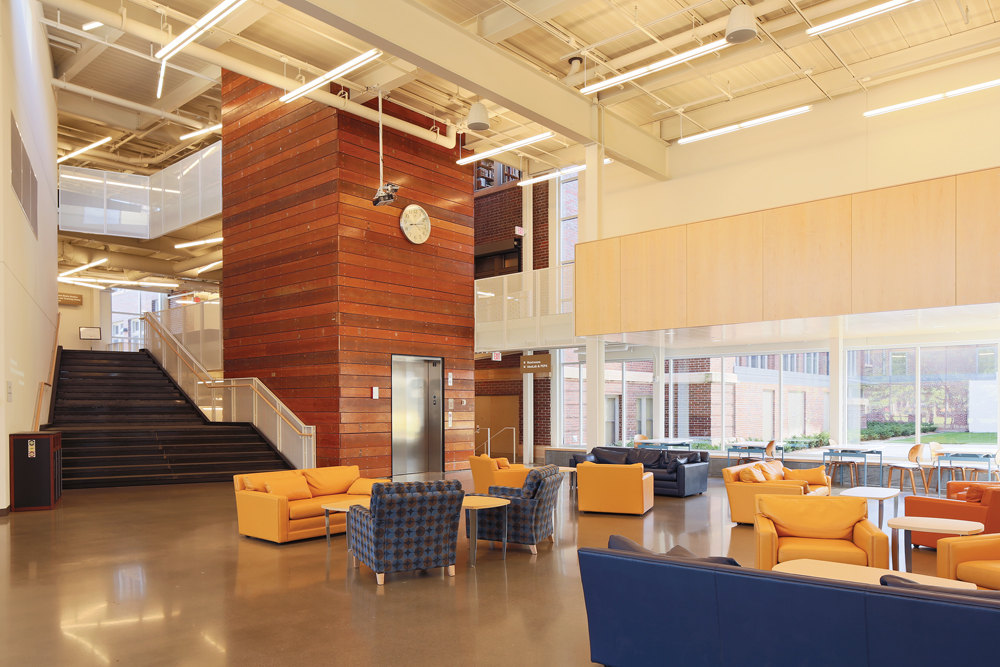Colleges and universities have been in the forefront of green building for more than a decade. Recently, pioneering academic institutions have been testing the limits of energy-conserving technologies, devising new ways to pay for sustainability extras, and extending sustainability to the whole campus.
Colby College, Waterville, Maine, this year became the fourth college in the country to achieve carbon neutrality. To help Colby reduce its reliance on oil by 90% and cut its greenhouse gas emissions by 70%, Architectural Resources Cambridge, Rist-Frost-Shumway Engineering, and PC Construction devised a 15,800-sf biomass cogeneration heating plant that burns thousands of tons of forest waste harvested within a 50-mile radius of the campus. It is expected to save the college $1.4 million a year in fuel costs.
Carleton College, Northfield, Minn., took sustainability to its roots by converting a historic middle school into the Weitz Center for Creativity. The LEED Gold adaptive reuse/addition created a multifunctional, interdisciplinary workshop for a variety of academic disciplines, as well as a community spaces and centralized support for multimedia and interactive technologies.
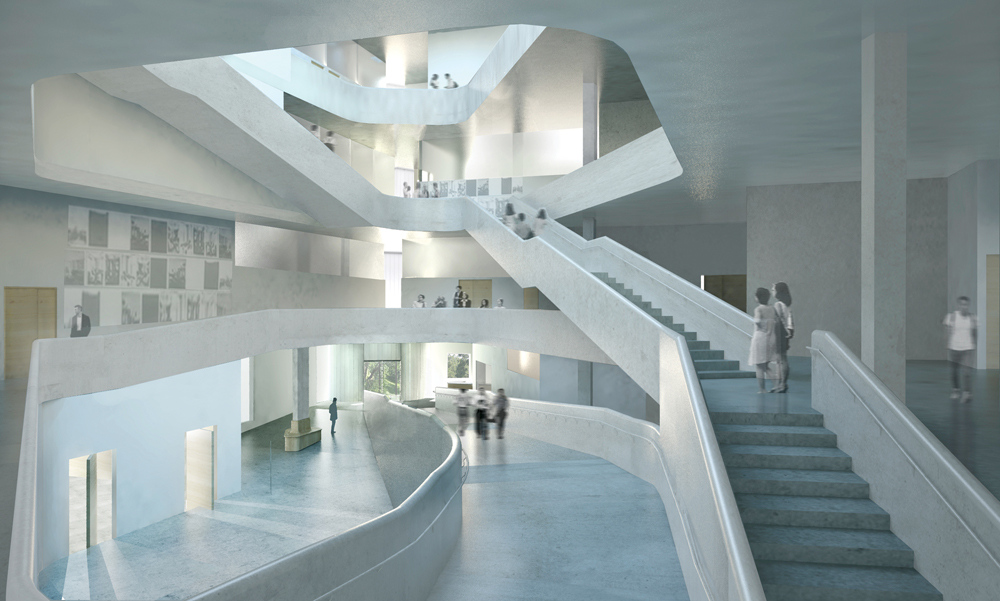
The Visual Arts Building at the University of Iowa, designed by Steven Holl Architects and BNIM, broke ground in September. Upon completion in 2016, the 126,000-sf loft-like structure will use active slab heating and cooling into the exposed bubble-deck structure to reach LEED Gold certification. Also on the Building Team: Buro Happold (SE), Design Engineers (mechanical), Shive-Hattery (CE), Transsolar (sustainability engineer), L’Observatoire International (lighting consultant), WJ Higgins & Co. (curtain wall consultant), The Sextant Group (AV), and Miron Construction (CM). PHOTO: COURTESY STEVEN HOLL ARCHITECTS
Dialing for dollars at the DOE
Universities are upping their game when it comes to finding ways to pay for supergreen projects. Oakland University, Rochester, Mich., was able to reach LEED Platinum for its new $64 million Human Health Building thanks in part to a $2.7 million grant from the U.S. Department of Energy.
The extra money, coupled with funds from the state of Michigan, allowed designer SmithGroupJJR and The Christman Company (CM) to proceed with a 340-well geothermal system, 117 vacuum tube solar thermal panels, a desiccant dehumidification system, and solar domestic water heating. Two hundred roof-mounted solar PVs generate 45 kW, or 3% of the project’s electricity. Total annual energy savings: 35%.
Taking sustainability beyond the individual building
Collegiate master planning is taking on a new dimension in Palm Springs, Calif., where HGA Architects and Engineers recently completed the first phase of the new West Valley Campus at the 12,000-student College of the Desert. A 50,000-sf cluster of academic buildings will house spaces for basic skills labs, culinary arts, and a Desert Energy Enterprise Center that will provide training in the engineering of solar panels and wind turbines. The goal: to have the campus produce more energy than it consumes.
In fact, the plan goes beyond net-zero-plus energy to include NZ carbon, water, waste, and materials. On-site photovoltaics will produce electricity; 60 of the 119 acres of the site will be devoted to a solar farm, which the college will lease to a third party to provide renewable energy for the Coachella Valley—and revenue for the college.
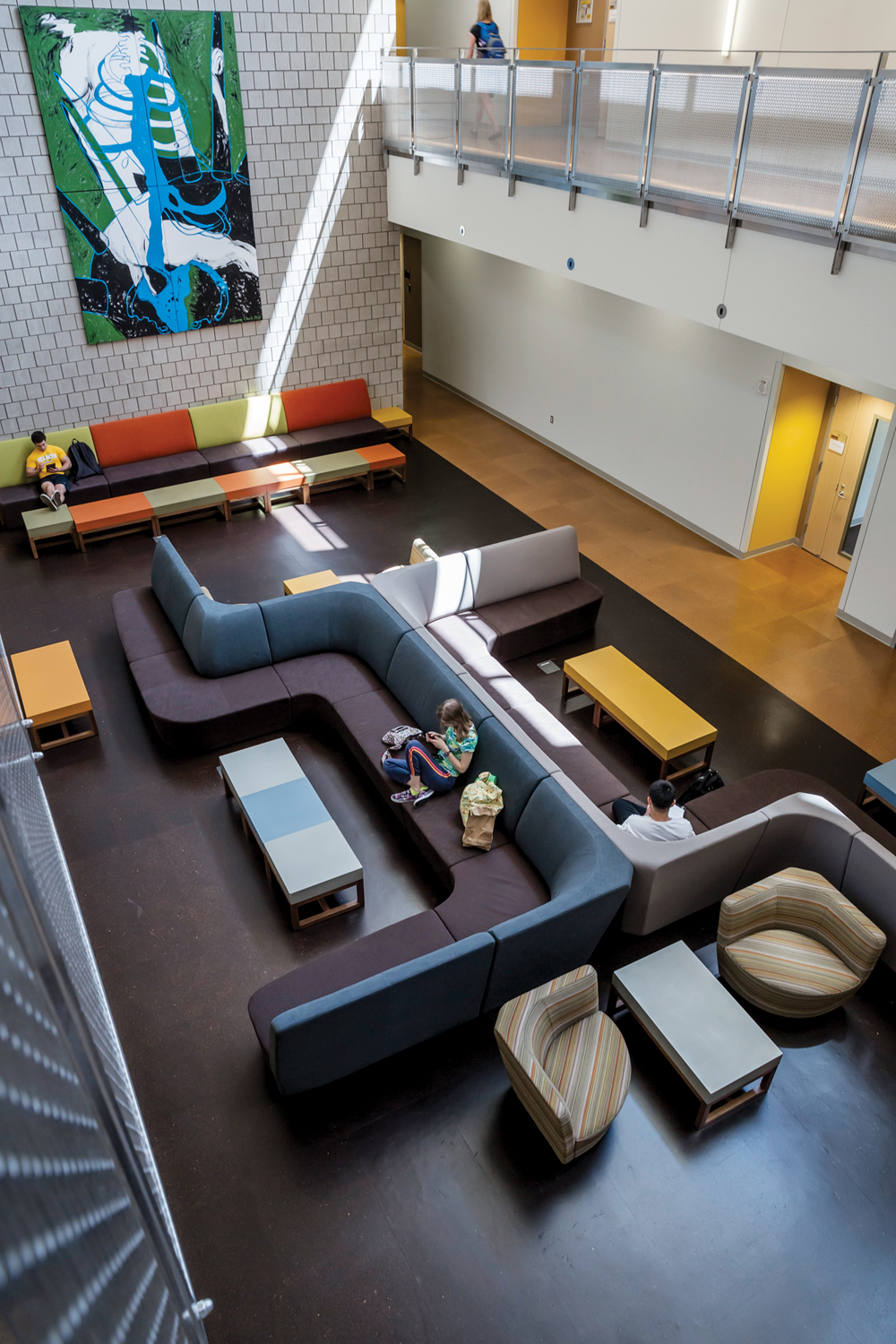
The 160,260-sf, LEED Platinum Human Health Building at Oakland University, Rochester, Mich. The five-story facility, completed in mid-2012, provides a collaborative setting for the Schools of Nursing and Health Sciences, which had outgrown their separate facilities. SmithGroupJJR provided architectural, interior, and landscape design, engineering (MEP, SE, CE), lab planning, and LEED consulting. The Christman Company was the CM. PHOTO: PRAKASH PATEL
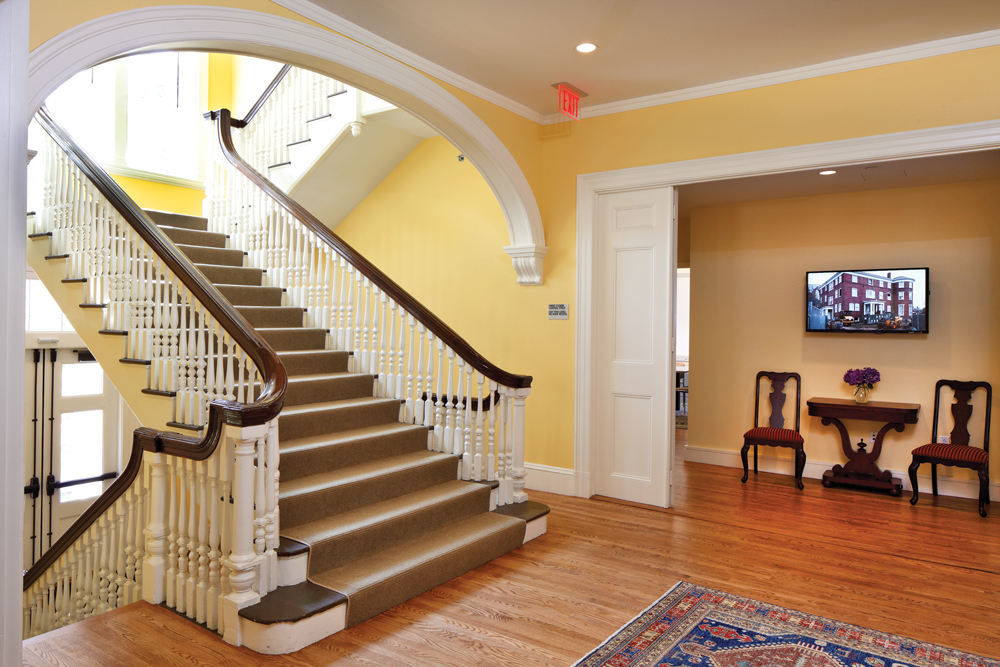
Fay House, the 1807 Federalist structure that once served as the original home of Radcliffe College, was converted to an administrative building for the Radcliffe Institute for Advanced Study at Harvard. The Building Team for the LEED Gold renovation—the oldest LEED-certified building in the U.S., and second-oldest in the world (after Venice’s Sede Centrale, 1453): Venturi, Scott Brown and Associates (now VSBA), Foley Buhl Roberts & Associates (SE), Cosentini Associates (MEP), Green International Affiliates (CE), Grenald Waldron Associates (lighting designer), Steven Stimson Associates (landscape architect), Harvard Green Building Services (sustainability consultant), and Shawmut Design and Construction (CM). PHOTO: MATT WARGO / COURTESY VSBA, LLC
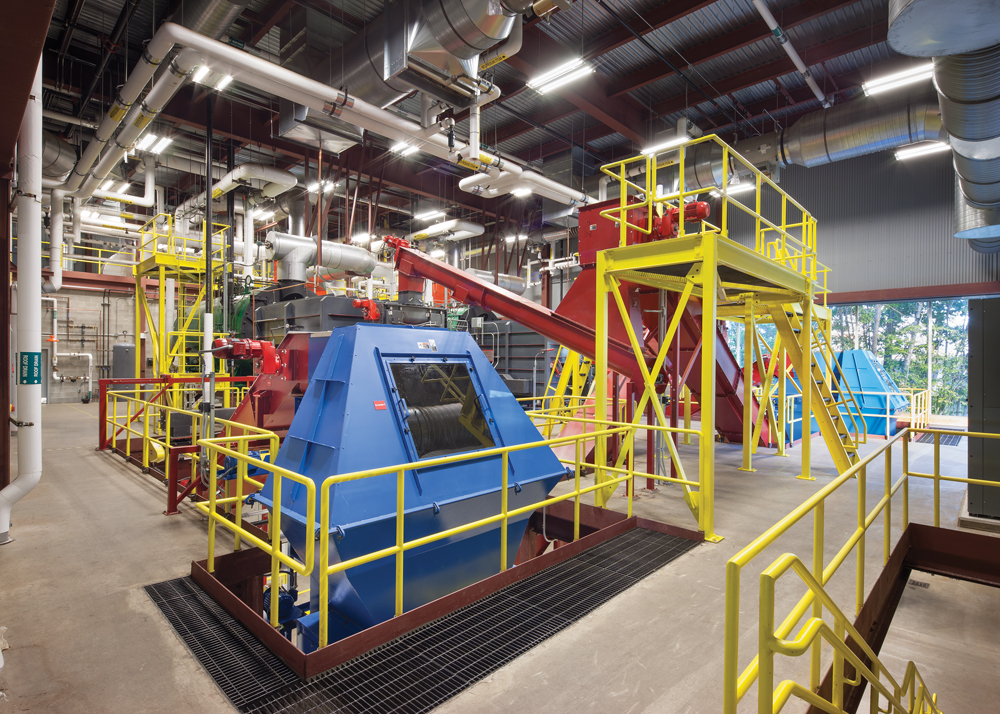
Twin 400-hp biomass-fueled boilers in the $11 million, LEED Gold cogeneration plant at Colby College produce steam for heat, hot water, and cooking and generate up to 10% of electricity used on the Waterville, Maine, campus. PHOTO: © JOHN HORNER, COURTESY ARCHITECTURAL RESOURCES CAMBRIDGE
Community college gets creative to save energy
Haywood Community College, Clyde, N.C., which serves 2,700 full-time and 6,000 part-time students, has gained an international reputation in the creative arts since opening in 2006.
For its new 41,000-sf Creative Arts Building, the college tasked Raleigh-based Innovative Design with reducing energy use by 60%, from 91.6 kBtu/sf/year for a standard building down to 36.0 kBtu/sf/year—and LEED Platinum certification would be nice, too.
This was no mean task, given the programming demands of the facility. The clay studio has eight electric and three gas kilns, all energy hogs. The jewelry program requires enhanced lighting so that students can see their work. The wood studio throws lots of dust into the air, necessitating extensive ventilation.

The wood studio in the LEED Platinum Creative Arts Building at Haywood Community College, Clyde, N.C. The Building Team of Innovative Design (architect), Elm Engineering, B&F Consulting, and Landis Inc. reduced the project’s energy consumption to 17.8 kBtu/sf/year.
The Building Team attacked these problems with a battery of options, starting with optimal building orientation, daylighting, operable windows, stack ventilation shafts, rainwater harvesting, and a high-mass building envelope.
On top of these, the team specified more advanced technologies—152 solar thermal collectors that feed a radiant floor heating system and a 50-ton absorption chiller; seven solar collectors that supply most of the building’s hot water needs; and 468 rooftop PV modules capable of generating 112 kW of power.
The PVs are owned and operated by solar developer FLS Energy, Asheville, which financed the system and sells the power to Duke Energy–Progress. The college will have the option of buying back the PV system in six or seven years.
Since its opening last March, the building’s actual energy consumption has been tracking at 17.8 kBtu/sf/year, well below the anticipated 36.0 kBtu/sf/year.
But the facility’s true success may lie in its positive impact on Haywood’s students. “I’ve already experienced a change in the quality of our students’ work,” says Terry Gess, Chair of Professional Arts. “I attribute this to the many ways that the building works splendidly, especially the quality of light and the well-designed spaces.”Design-builder McGough Companies and Meyer Scherer & Rockcastle (architect) created a high-performing exterior envelope while saving the original brick and stone detailing, interior wood trim, and slate chalkboards.
Related Stories
Codes and Standards | Apr 8, 2024
Boston’s plans to hold back rising seawater stall amid real estate slowdown
Boston has placed significant aspects of its plan to protect the city from rising sea levels on the actions of private developers. Amid a post-Covid commercial development slump, though, efforts to build protective infrastructure have stalled.
Sustainability | Apr 8, 2024
3 sustainable design decisions to make early
In her experience as an architect, Megan Valentine AIA, LEED AP, NCARB, WELL AP, Fitwel, Director of Sustainability, KTGY has found three impactful sustainable design decisions: site selection, massing and orientation, and proper window-to-wall ratios.
Brick and Masonry | Apr 4, 2024
Best in brick buildings: 9 projects take top honors in the Brick in Architecture Awards
The Ace Hotel Toronto, designed by Shim-Sutcliffe Architects, and the TCU Music Center by Bora Architecture & Interiors are among nine "Best in Class" winners and 44 overall winners in the Brick Industry Association's 2023 Brick in Architecture Awards.
Retail Centers | Apr 4, 2024
Retail design trends: Consumers are looking for wellness in where they shop
Consumers are making lifestyle choices with wellness in mind, which ignites in them a feeling of purpose and a sense of motivation. That’s the conclusion that the architecture and design firm MG2 draws from a survey of 1,182 U.S. adult consumers the firm conducted last December about retail design and what consumers want in healthier shopping experiences.
Healthcare Facilities | Apr 3, 2024
Foster + Partners, CannonDesign unveil design for Mayo Clinic campus expansion
A redesign of the Mayo Clinic’s downtown campus in Rochester, Minn., centers around two new clinical high-rise buildings. The two nine-story structures will reach a height of 221 feet, with the potential to expand to 420 feet.
Sports and Recreational Facilities | Apr 2, 2024
How university rec centers are evolving to support wellbeing
In a LinkedIn Live, Recreation & Wellbeing’s Sadat Khan and Abby Diehl joined HOK architect Emily Ostertag to discuss the growing trend to design and program rec centers to support mental wellbeing and holistic health.
Architects | Apr 2, 2024
AE Works announces strategic acquisition of WTW Architects
AE Works, an award-winning building design and consulting firm is excited to announce that WTW Architects, a national leader in higher education design, has joined the firm.
Office Buildings | Apr 2, 2024
SOM designs pleated façade for Star River Headquarters for optimal daylighting and views
In Guangzhou, China, Skidmore, Owings & Merrill (SOM) has designed the recently completed Star River Headquarters to minimize embodied carbon, reduce energy consumption, and create a healthy work environment. The 48-story tower is located in the business district on Guangzhou’s Pazhou Island.
K-12 Schools | Apr 1, 2024
High school includes YMCA to share facilities and connect with the broader community
In Omaha, Neb., a public high school and a YMCA come together in one facility, connecting the school with the broader community. The 285,000-sf Westview High School, programmed and designed by the team of Perkins&Will and architect of record BCDM Architects, has its own athletic facilities but shares a pool, weight room, and more with the 30,000-sf YMCA.
Market Data | Apr 1, 2024
Nonresidential construction spending dips 1.0% in February, reaches $1.179 trillion
National nonresidential construction spending declined 1.0% in February, according to an Associated Builders and Contractors analysis of data published today by the U.S. Census Bureau. On a seasonally adjusted annualized basis, nonresidential spending totaled $1.179 trillion.


